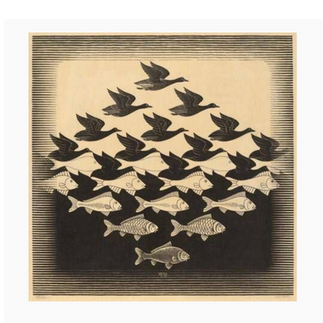The Wonderful World of Patterns, Repetitions, Design, and Art
- Lea Passi Even

- Aug 15, 2023
- 6 min read
I really like art and get inspiration from visits to museums. Usually, I don't look for a connection between exhibitions and artists, and enjoy each one separately. Recently, I visited two different and seemingly unrelated exhibitions, but a few days ago the connection between them suddenly became clear to me, it's about - patterns/paving surfaces/repeating patterns.
Patterns-1, Pop-Art and textiles
Last May, I visited the London Fashion and Textile Museum in Bermondsey, Bohemian and charming neighborhood, not far from London Bridge. The exhibition was called Andy Warhol the textiles. Let's start with the fact, that I didn't even know that Andy Warhol illustrated canvases, like most people, his name was associated in my mind with Pop Art.
It turns out that fabrics illustrations with repeating patterns, intended to be his privet art, but eventually, they were sold to commercial companies, and for a large part of them he did not receive credit, the company that bought the patterns put it's label on it (that's why to catalogue them, to date them back to when they were created is quite hard, and in this exhibition they are trying to do just that, it's summarized in the book of the exhibition which is beautiful).

The illustrations were taken from the world of animals, plants and everyday life: butterflies, fruits such as lemons, melons, or from the still life, oysters, flowers, pots, perfume bottles, ice creams, and more, printed on fabric. Sometimes he used the same design in several different sizes, usually also choosing a certain color palette each time. In this way, by replicating and incorporating art into consumer products, even ordinary people could afford to purchase works of art. The fabrics were mainly used for clothing, curtains and even wrapping paper for gifts. The refreshing colors, the simplicity and sometimes even the naivety of the prints, made me walk around the museum with a big smile, I would happily wear dresses with Andy Warhol prints!
New York was considered the center of fashion and textiles in the 1950s and collaborations between designers, artisans and fabric manufacturing companies flourished. One of the well-known collaborations was in 1954 - when Dan Fuller, from the textile company Fuller Fabrics, initiated a collaboration with artists such as Picasso and Miro. In 1956 the company even participated in an exhibition called Textile USA at the Moma Museum in New York with works by these artists and more. Andy Warhol who always knew how to identify trends, and was aware of this one, designed 3 floral samples for the company after several years.
Photos taken by me, at Fashion + Textile Museum May 2023
A little bit about the artist, he became famous as a Pop Art artist - turned popular products into art, blurring the boundaries between industrial products and art. He worked a lot in the world of advertising, designed packaging, illustrated magazines and newspapers. When he tried to be a "serious" artist, he was less successful, so he took everyday consumer goods such as $ bills, coke cans, figures of famous people (one of the well-known was Marilyn Monroe), and turned them into art! Andy Warhol studied at the Technological Institute of Art, Design and Illustration, and started a career as an industrial designer. He called himself a "business artist" his philosophy as he wrote in his book "The Philosophy of Andy Warhol" was, as he summed it up in one sentence, "Being good in business is the most fascinating kind of art, and good business is the best art"
Patterns 2- repeating, changing, realistic and surrealistic
In July, I visited The Hague, Netherlands, to attend an exhibition held in commemoration of the 125th anniversary of the birth of the esteemed Dutch artist Maurits Cornelis Escher, and his revered teacher and friend Samuel Jessurun Mesquita (who was murdered in the Holocaust). The museum is housed in the Winter Palace where the Queen Mother lived, which is charming in itself. Escher, known for works that captivates the viewer's perception, invites you to gaze at his images for hours, provoking contemplation whether you're observing a waterfall or a fountain, individuals ascending or descending stairs, and more. Remarkably, years following his passing, mathematicians who delved into his creations unveiled underlying mathematical constructs, underscoring that his art, driven by a fascination for perspective, was grounded in intricate mathematical models. Interestingly, despite identifying as a modest mathematician and considering himself a somewhat unexceptional artist, Escher's legacy stands as a testament to his exceptional artistic and mathematical fusion.
Escher created mostly prints. He designed several types of templates
1. Patterns that start with a certain element and end with another element (the first picture from the left)
Like for example "Sky & Water":- Fish that gradually turn into birds. The piece is in black and white, the gray fish are white on a black background and end with black birds on a white background.
2. A pattern that starts with real elements and ends with abstract shapes (the picture in the middle)
A work that begins (or ends, it's all a matter of perspective) with small gray birds that grow until they become black and white abstract shapes freed from all limitations. The piece is called "Liberation".
3. Patterns that contain repeating shapes that look like tiles (first picture on the right)
In these works there is no beginning, no end, and no gaps between the elements. This is a surface without a background, if we attach another identical tile to the edge of the tile, an infinite repetition of the elements will be possible.
What is special about Asher's "tiles" is the contrast in colors, which allows one to see the same repeating shape in the light color as well as the dark color. Most of them consist of shapes of animals or people and were created in the twenties of the last century.
A bit about the artist, M.C. Escher came from an wealthy family in Leeuwarden, Holland. In the 1920's, he studied at The School of Architecture and Decorative Arts in Haarlem. At first in the architecture major, and then he switched to design. He was influenced by his teacher J. M. Mesquita who created fabric designs in the Art Nouveau style, and noticed his graphic talent and encouraged him to peruse graphic design . Due to little interest in these works he abandoned this style but returned to it following a visit to the Alhambra Palace in Spain in 1936 where he was fascinated by the painted Islamic tiles.
The right picture was taken by me at Exhibition in The Hague - Escher in the Palace
In July 2023, the other 2 were taken from the Smartify app I used to navigate the exhibition.
What is common and different between the two artists?
The works of both, very influential in the art world, are quite different in terms of style, themes and artistic approach. There is no direct connection between their work, as they were active in different artistic movements even though some of the years they were active overlapped (the first in Europe and the second in the US). They also explored different concepts. However, there are some points where their work intersects.
Repetition and Patterns
Asher and Warhol used repetition and patterns in their work, albeit in different ways. Warhol's took iconic images, such as soup cans or celebrity portraits, and he also did it with his fabric prints, which were fashioned from everyday products or natural items. Asher, on the other hand, used repetitions to create complex sequences and impossible architectural structures that challenge our perception of reality.
"Playful" Exploration
Both artists had a "playful" and imaginative approach to their work. With Asher the optical illusions, and the impossible structures, a combination of realistic and surreal, deceive our understanding of his perception of space. While Warhol's use of vibrant colors, bold imagery, and everyday items in his fabric prints are full of humor - see prints of ice cream cones or perfume bottles and more.
Blurring Boundaries
Both Ascher and Warhol blurred the lines between different artistic disciplines. Warhol's exploration of art and consumer products, as well as his ventures into music and film, challenged the traditional boundaries between consumer goods and art. Ascher pushed the boundaries between art, mathematics and science and found new ways in which they could intersect.
Ultimately, both artists made significant contributions to the art world, but their work is distinguished by their individual approaches and the specific themes they explored.
Patterns 3- Artificial intelligence, the sky is the limit!
Recently, like everyone else, I was exposed to artificial intelligence and created, among other things, tile patterns, it's not the main thing I focused on, but the unbearable ease of creating in Midjourney opened up new worlds for me and everyone. I will not enter into a debate here as to whether such a work is really art, it will take time to define it because we are in the midst of the process of exploring it, what is certain, artists and creators will produce completely different things than ordinary people. Designers and artists will work harder, develop the work and take it in their own directions, in my opinion it is definitely art! The many hours I spend on these platforms would be countless if I had to put my ideas on paper. The commercial potential is endless, fabrics for clothes, dresses, shirts, upholstery, bags, sports shoes and more. I wonder what Andy Warhol would have done with it!
Finally, I will connect from another angle to the theme of continuations and repetitions through paved/decorated leather, the new bags I designed recently, in which I chose to used embossed leather, adds another dimension of elegance and interest!
































Comments